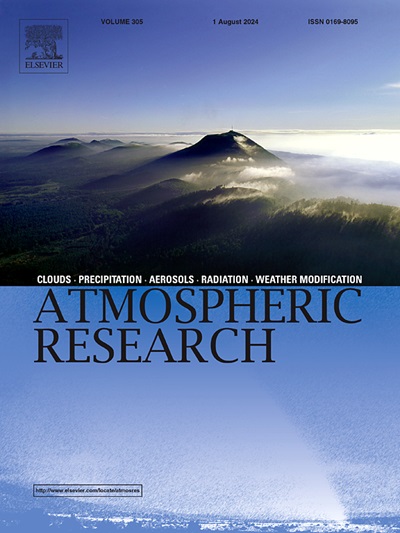Extreme wildfires over Northern Greece during Summer 2023 – Part B. Adverse effects on regional air quality
IF 4.5
2区 地球科学
Q1 METEOROLOGY & ATMOSPHERIC SCIENCES
引用次数: 0
Abstract
The frequency, severity, and duration of wildfires are on the rise worldwide, underscoring the importance of comprehending the health impacts of wildfire exposure. The main aim of this work is to examine the effects that the Northern Greece forest fires during August 2023 had on regional air quality levels. On August 21st, a massive forest fire started within the Dadia Forest National Park, a protected area, nearby the city of Alexandroupoli. During the nearly ten-day duration of the fire, approximately 80,000 ha burned, while the strong prevailing easterly winds transported smoke particles and biomass burning gases over Northern Greece and the Mediterranean Sea, reaching the coasts of Italy and Tunisia. Using both spaceborne observations of nitrogen dioxide (NO2), formaldehyde (HCHO) and carbon monoxide (CO), as well as ground-based instrumentation in the city of Thessaloniki, the extend of the degradation of air quality has been quantified. The spatially resolved Sentinel-5P TROPOspheric Monitoring Instrument (S5P/TROPOMI) observations showed how the fire plumes spread throughout Northern Greece, degrading massively the air quality near the fire event as well as over Thessaloniki, some 300 km to the west. NO2 levels were enhanced up to 82 % over the fire location whereas in the metropolis of Thessaloniki by 36 %, testifying to the extent of the fire, the dispersion of the plume and the emission strength. During the main fire days HCHO levels were shown to be enhanced by 54 % in the greater area of Alexandroupoli and by 114 % in the vicinity of Thessaloniki, in line with other works. The longer-lived CO was found similarly enhanced in both locations, ∼26 %, with a longer lasting effect to regional air quality. Ground-based remote sensing resulted in similar findings with MAX-DOAS spectrophotometer observations of nitrogen dioxide capturing the build-up of the transported NO2 load over Thessaloniki with morning levels reaching 30 Pmolec/cm2, testifying to the magnitude of the transported NO2 loads well beyond the stable variability of the typical August mean NO2 levels of 10 Pmolec/cm2. The MAX-DOAS also measured increased formaldehyde levels throughout the days of the fire event, between 25 and 35 Pmolec/cm2, unaffected by the photochemical processes destroying NO2, and well beyond the typical summertime levels of ∼12 Pmolec/cm2. FTIR spectroscopy observations, also routinely performed over Thessaloniki, revealed that the long-lived carbon monoxide levels exceeded the expected background loads by more than 100.00 ± 10.61 ppb on the second major fire day. The predicted frequency increase of such major wildfire events places an imperative need for changes in the typical urban air quality monitoring practices currently in place, to account for unexpected degradation of the breathable air, as well as changes on how mitigation measures are presently applied by regional and central government.
2023年夏季希腊北部的极端野火- b部分。对区域空气质量的不利影响
在世界范围内,野火的频率、严重程度和持续时间都在上升,这凸显了了解野火对健康影响的重要性。这项工作的主要目的是研究2023年8月希腊北部森林大火对区域空气质量水平的影响。8月21日,亚历山德鲁波利市附近的保护区达迪亚森林国家公园发生了一场大规模的森林火灾。在大火持续近10天的时间里,大约8万公顷土地被烧毁,同时盛行的强劲东风将烟雾颗粒和生物质燃烧气体带到希腊北部和地中海,到达意大利和突尼斯海岸。利用对二氧化氮(NO2)、甲醛(HCHO)和一氧化碳(CO)的星载观测以及塞萨洛尼基市的地面仪器,对空气质量退化的程度进行了量化。Sentinel-5P对流层监测仪器(S5P/TROPOMI)的空间分辨率观测显示了火羽如何在希腊北部蔓延,严重降低了火灾事件附近以及以西约300公里的塞萨洛尼基上空的空气质量。在火灾地点,二氧化氮水平提高了82%,而在塞萨洛尼基大都市,二氧化氮水平提高了36%,这证明了火灾的范围、烟羽的扩散和排放强度。与其他工作一致,在主要的5天里,亚历山德罗波里大地区的HCHO水平提高了54%,塞萨洛尼基附近地区提高了114%。在这两个地区,较长寿命的CO含量都得到了类似的提高,约26%,对区域空气质量的影响持续时间更长。地面遥感的MAX-DOAS分光光度计对二氧化氮的观测也得出了类似的结果,捕获了塞萨洛尼基上空输送的二氧化氮负荷的积累,早晨的二氧化氮水平达到30 Pmolec/cm2,证明了输送的二氧化氮负荷的大小远远超过了典型的8月平均二氧化氮水平10 Pmolec/cm2的稳定变化。MAX-DOAS还测量了火灾发生当天甲醛水平的升高,在25至35 Pmolec/cm2之间,不受光化学过程破坏NO2的影响,远远超过了典型的夏季水平12 Pmolec/cm2。在塞萨洛尼基进行的FTIR光谱观测也显示,在第二个主要火灾日,长寿命的一氧化碳水平超过预期的背景负荷超过100.00±10.61 ppb。预计这类重大野火事件发生的频率会增加,因此迫切需要改变目前典型的城市空气质量监测做法,以考虑到可呼吸空气的意外退化,并改变区域和中央政府目前如何实施缓解措施。
本文章由计算机程序翻译,如有差异,请以英文原文为准。
求助全文
约1分钟内获得全文
求助全文
来源期刊

Atmospheric Research
地学-气象与大气科学
CiteScore
9.40
自引率
10.90%
发文量
460
审稿时长
47 days
期刊介绍:
The journal publishes scientific papers (research papers, review articles, letters and notes) dealing with the part of the atmosphere where meteorological events occur. Attention is given to all processes extending from the earth surface to the tropopause, but special emphasis continues to be devoted to the physics of clouds, mesoscale meteorology and air pollution, i.e. atmospheric aerosols; microphysical processes; cloud dynamics and thermodynamics; numerical simulation, climatology, climate change and weather modification.
 求助内容:
求助内容: 应助结果提醒方式:
应助结果提醒方式:


